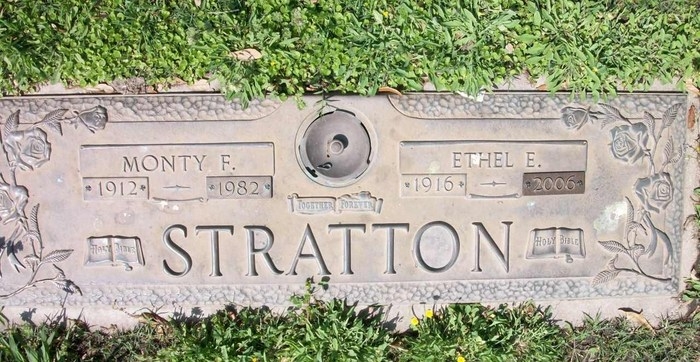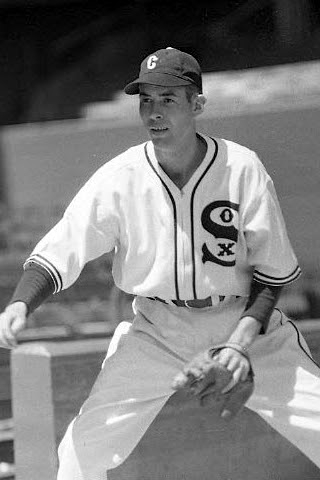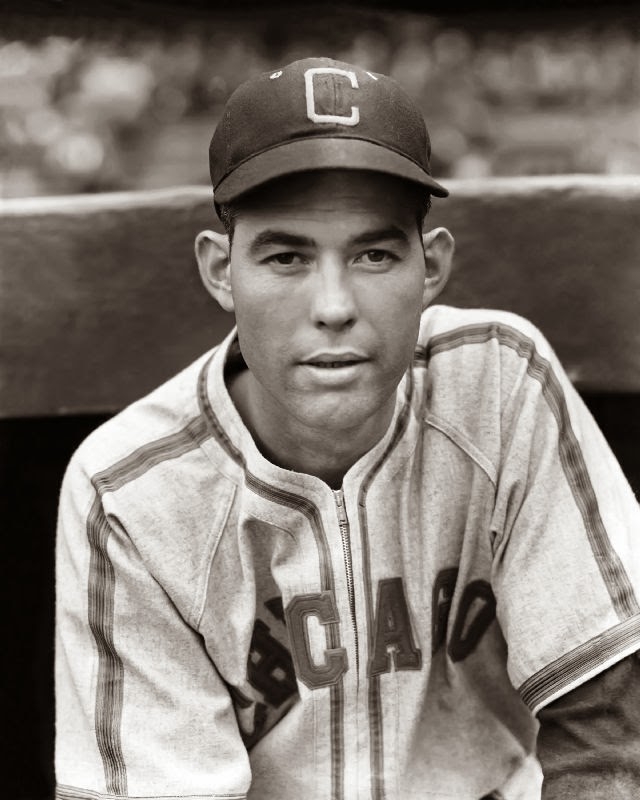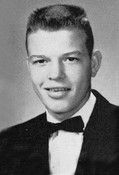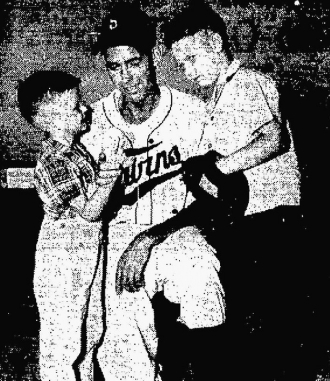Monty Stratton: Baseball's version of profile in courage
November 27, 2018 by retrosimba
After an accidental shooting ended his major-league pitching career, Monty Stratton made a courageous comeback to professional baseball, inspired an Oscar-winning movie and experienced more personal tragedy.
On Nov. 28, 1938, Stratton had his right leg amputated above the knee because of a bullet wound inflicted when his pistol discharged in its holster.
Stratton, 26, was a White Sox starting pitcher who earned 15 wins in each of the previous two seasons.
Determined to play competitively again, Stratton taught himself to pitch, hit and field on a prosthetic wooden leg. In 1946, eight years after the accident, he accomplished his goal, pitching a full season in the minor leagues and compiling 18 wins.
Hollywood came calling and three years later, in 1949, “The Stratton Story,” starring Jimmy Stewart, was released in movie theaters.
After that, Stratton led a mostly peaceful life on his Texas farm until another tragic incident occurred.
Rise and fall
Monty Franklin Pierce Stratton was born in 1912 in the east Texas prairie community of Wagner, near Greenville. His parents were farmers who produced cotton and grain. After his father died, Stratton, who was a teen, helped his mother run the farm. He played for local semipro teams, joined a minor-league club and got signed by a White Sox scout.
A 6-foot-5 right-hander, Stratton made his major-league debut with the White Sox in June 1934. He came to prominence in 1937 when he was named an American League all-star and posted a 15-5 record and 2.40 ERA. Stratton followed that with a 15-9 mark in 1938.
On Sunday, Nov. 27, 1938, Stratton, his wife Ethel and their son Monty Jr. visited his mother at her farmhouse. In the afternoon, Stratton took his .32-caliber automatic pistol and went out alone into the nearby woods “with the promise he’d bring back some rabbits, or, failing in that, would at least get some practice in marksmanship,” The Sporting News reported.
After taking a shot at a rabbit, Stratton put the pistol in a belt holster and was walking along a thicket, about a half-mile from the house, when the gun discharged. The bullet entered below his right hip, severed an artery and lodged near his knee. Stratton, weak from blood loss, crawled to within about 250 yards of the house. Ethel heard his shouts, got him into their car and rushed him to a hospital, the Chicago Tribune reported.
After receiving a series of blood transfusions, Stratton showed “great improvement,” but the next day, Nov. 28, 1938, gangrene set in and doctors determined amputation was imperative, the Tribune reported. The day of the amputation also was the birthday of 1-year-old Monty Jr.
On Dec. 2, 1938, Stratton, in his first interview since the accident, said from his hospital bed, “It’s been tough lying here, knowing that my baseball career is over, but I’m alive and have my wife and youngster and friends. What more could a man want?”
Moving on
Stratton’s misfortune was major news and stunned baseball fans. Cubs trainer Andy Lotshaw cautioned, “The only shooting a baseball player should do is in a 26 dice game and then only when the company is congenial.”
The White Sox and Cubs agreed to play an exhibition benefit game to raise funds to help with Stratton’s medical bills. White Sox owner J. Lou Comiskey told Stratton he would have a job with the club as long as he wanted.
The benefit game was played May 1, 1939, at Comiskey Park. The White Sox won, 4-1, beating Dizzy Dean before 25,594 spectators. Stratton delivered the ceremonial first pitch. “It was apparent, however, he couldn’t put his weight behind his pitches without losing balance,” the Tribune reported.
More than $29,000 was raised, according to the Tribune.
“Stratton still has aspirations to continue as a pitcher when he becomes accustomed to the artificial limb,” The Sporting News reported.
Stratton spent the next two years, 1940 and 1941, as a White Sox coach and sometimes pitched batting practice. A second son, Dennis, was born in 1940.
In 1942, Stratton became manager of the minor-league Lubbock Hubbers but quit after 10 days because the bus rides were too difficult on his leg, The Sporting News reported.
Comeback trail
Stratton spent another two years, 1942 and 1943, working on his pitching. Ethel was his catcher. When she was unavailable, he pitched to a target painted on the side of a barn and had his sons retrieve the balls, according to The Sporting News.
Ready to pitch competitively again, Stratton organized a semipro team in Greenville and pitched in games in 1944 and 1945.
In 1946, Stratton, 34, contacted the owner of the minor-league Greenville Majors of the East Texas League and asked for a chance to play, but the owner wanted him as a manager, not a pitcher. Stratton wrote to the other seven clubs in the league and heard from Art Willingham, owner of the Sherman Twins, who signed him to pitch.
On April 30, 1946, Stratton pitched a one-hitter in a 6-1 win against Greenville.
When he faced the Texarkana Bears, seven batters attempted bunts in the first six innings. Three of them struck out. The other four bunted, but Stratton fielded all flawlessly, throwing out three from a prone position.
“He can and does field bunts, even though he topples over easily,” The Sporting News observed. “Stratton believes that the more bunts attempted against him, the better he will be able to field them.”
In a rematch against Greenville, Stratton batted with a runner on first, two outs, and singled to center. As the throw went to second, Stratton “set out with that peculiar hop-skip he used and was about two-thirds of the way to first when he fell,” The Sporting News reported.
The crowd gasped and the infielder, seeing what happened, fired the ball to first. “When Monty fell, he started crawling,” writer D.A. Blocker observed. “The ball beat his last desperate lunge by an eyelash. Monty got up, brushed himself off and went on out to the mound to receive an ovation that lasted for at least 10 minutes. There was hardly a dry eye in the whole park.”
Stratton was visited that summer by screenwriter Douglas Morrow and signed a deal to give Morrow the movie rights to his life story.
Stratton finished the 1946 season with an 18-8 record and pitched 218 innings in 27 starts.
Lights, cameras
MGM agreed to make a movie based on Morrow’s screenplay. Sam Wood was hired to direct and filming was scheduled to begin in 1948. Wood had directed two Marx Brothers hits, “A Night at the Opera” (1935) and “A Day at the Races” (1937) as well as dramas such as “Goodbye, Mr. Chips” (1939), “The Pride of the Yankees” (1942) and “For Whom the Bell Tolls” (1943).
Stratton pitched one more minor-league season, posting a 7-7 record for the 1947 Waco Dons, before heading to Hollywood in 1948 to be the movie’s technical advisor.
MGM chose Van Johnson to play the role of Stratton and hired retired big-leaguers Harry Danning, Bob Meusel and Red Ruffing to coach him on how to be a ballplayer, but they “found it more difficult to teach Van to pitch and handle a bat than to balance peas on a knife,” The Sporting News reported.
MGM wanted Robert Taylor to replace Johnson, but Taylor declined. Ronald Reagan reportedly sought the role, but the studio preferred Jimmy Stewart or Gregory Peck. Stewart got the part and MGM cast June Allyson as Stratton’s wife. Agnes Moorehead as Stratton’s mother and Frank Morgan as a scout who signed and mentored Stratton. Morgan had played the roles of The Wizard and Professor Marvel in “The Wizard of Oz” (1939).
Several former and active major-leaguers appeared in the film. Indians pitcher Gene Bearden, retired catcher Bill Dickey, Cubs coach Merv Shea and former White Sox manager Jimmy Dykes got credited parts. Among the ballplayers making uncredited appearances were Gene Mauch and Hank Sauer.
Stratton was delighted by Stewart’s portrayal. “They’ll be sending him a contract after scouts get a squint at him in action,” Stratton said.
Said Dykes: “Stewart is doing an excellent job as a pitcher for an actor.”
The film opened in theaters in June 1949 and was a box-office success. Trailer
Daily Variety called it a “human drama as all-American as the sport which motivates it.”
The Hollywood Reporter surmised the film “touches the heart to just the same degree that it entertains.”
The movie fictionalized many key events, showing Stratton using a rifle instead of a pistol in the accident scene, and substituting an All-Star Game for the 1939 charity game, for instance.
Morrow won an Oscar for best writing, original story.
More misfortune
Stratton briefly played for minor-league teams in 1949, 1950 and 1953 before settling onto the family farm. He helped start the Greenville Little League program, according to the Greenville Herald-Banner.
Tragedy struck in June 1964 when Stratton’s youngest son, Dennis, 23, died. Dennis was found dead by his wife in the kitchen of their home, United Press International reported. A judicial officer ruled Dennis killed himself with a shotgun.
On Sept. 29, 1982, Monty Stratton, a longtime cigarette smoker, died of cancer at 70. Notified of Stratton’s death, Jimmy Stewart told United Press International, “We have exchanged Christmas cards ever since I did the picture … He was a very nice man who lived the sport of baseball and was a great credit to it.”
Ethel worked at a dress shop in Greenville and volunteered at a local hospital. She died in 2006 at age 90 at the home of a granddaughter.
Their eldest son, Monty Jr., served in the U.S Air Force and was 74 when he died on Oct. 18, 2012.
After an accidental shooting ended his major-league pitching career, Monty Stratton made a courageous comeback to professional baseball, inspired an Oscar-winning movie and experienced more personal tragedy.
On Nov. 28, 1938, Stratton had his right leg amputated above the knee because of a bullet wound inflicted when his pistol discharged in its holster.
Stratton, 26, was a White Sox starting pitcher who earned 15 wins in each of the previous two seasons.
Determined to play competitively again, Stratton taught himself to pitch, hit and field on a prosthetic wooden leg. In 1946, eight years after the accident, he accomplished his goal, pitching a full season in the minor leagues and compiling 18 wins.
Hollywood came calling and three years later, in 1949, “The Stratton Story,” starring Jimmy Stewart, was released in movie theaters.
After that, Stratton led a mostly peaceful life on his Texas farm until another tragic incident occurred.
Rise and fall
Monty Franklin Pierce Stratton was born in 1912 in the east Texas prairie community of Wagner, near Greenville. His parents were farmers who produced cotton and grain. After his father died, Stratton, who was a teen, helped his mother run the farm. He played for local semipro teams, joined a minor-league club and got signed by a White Sox scout.
A 6-foot-5 right-hander, Stratton made his major-league debut with the White Sox in June 1934. He came to prominence in 1937 when he was named an American League all-star and posted a 15-5 record and 2.40 ERA. Stratton followed that with a 15-9 mark in 1938.
On Sunday, Nov. 27, 1938, Stratton, his wife Ethel and their son Monty Jr. visited his mother at her farmhouse. In the afternoon, Stratton took his .32-caliber automatic pistol and went out alone into the nearby woods “with the promise he’d bring back some rabbits, or, failing in that, would at least get some practice in marksmanship,” The Sporting News reported.
After taking a shot at a rabbit, Stratton put the pistol in a belt holster and was walking along a thicket, about a half-mile from the house, when the gun discharged. The bullet entered below his right hip, severed an artery and lodged near his knee. Stratton, weak from blood loss, crawled to within about 250 yards of the house. Ethel heard his shouts, got him into their car and rushed him to a hospital, the Chicago Tribune reported.
After receiving a series of blood transfusions, Stratton showed “great improvement,” but the next day, Nov. 28, 1938, gangrene set in and doctors determined amputation was imperative, the Tribune reported. The day of the amputation also was the birthday of 1-year-old Monty Jr.
On Dec. 2, 1938, Stratton, in his first interview since the accident, said from his hospital bed, “It’s been tough lying here, knowing that my baseball career is over, but I’m alive and have my wife and youngster and friends. What more could a man want?”
Moving on
Stratton’s misfortune was major news and stunned baseball fans. Cubs trainer Andy Lotshaw cautioned, “The only shooting a baseball player should do is in a 26 dice game and then only when the company is congenial.”
The White Sox and Cubs agreed to play an exhibition benefit game to raise funds to help with Stratton’s medical bills. White Sox owner J. Lou Comiskey told Stratton he would have a job with the club as long as he wanted.
The benefit game was played May 1, 1939, at Comiskey Park. The White Sox won, 4-1, beating Dizzy Dean before 25,594 spectators. Stratton delivered the ceremonial first pitch. “It was apparent, however, he couldn’t put his weight behind his pitches without losing balance,” the Tribune reported.
More than $29,000 was raised, according to the Tribune.
“Stratton still has aspirations to continue as a pitcher when he becomes accustomed to the artificial limb,” The Sporting News reported.
Stratton spent the next two years, 1940 and 1941, as a White Sox coach and sometimes pitched batting practice. A second son, Dennis, was born in 1940.
In 1942, Stratton became manager of the minor-league Lubbock Hubbers but quit after 10 days because the bus rides were too difficult on his leg, The Sporting News reported.
Comeback trail
Stratton spent another two years, 1942 and 1943, working on his pitching. Ethel was his catcher. When she was unavailable, he pitched to a target painted on the side of a barn and had his sons retrieve the balls, according to The Sporting News.
Ready to pitch competitively again, Stratton organized a semipro team in Greenville and pitched in games in 1944 and 1945.
In 1946, Stratton, 34, contacted the owner of the minor-league Greenville Majors of the East Texas League and asked for a chance to play, but the owner wanted him as a manager, not a pitcher. Stratton wrote to the other seven clubs in the league and heard from Art Willingham, owner of the Sherman Twins, who signed him to pitch.
On April 30, 1946, Stratton pitched a one-hitter in a 6-1 win against Greenville.
When he faced the Texarkana Bears, seven batters attempted bunts in the first six innings. Three of them struck out. The other four bunted, but Stratton fielded all flawlessly, throwing out three from a prone position.
“He can and does field bunts, even though he topples over easily,” The Sporting News observed. “Stratton believes that the more bunts attempted against him, the better he will be able to field them.”
In a rematch against Greenville, Stratton batted with a runner on first, two outs, and singled to center. As the throw went to second, Stratton “set out with that peculiar hop-skip he used and was about two-thirds of the way to first when he fell,” The Sporting News reported.
The crowd gasped and the infielder, seeing what happened, fired the ball to first. “When Monty fell, he started crawling,” writer D.A. Blocker observed. “The ball beat his last desperate lunge by an eyelash. Monty got up, brushed himself off and went on out to the mound to receive an ovation that lasted for at least 10 minutes. There was hardly a dry eye in the whole park.”
Stratton was visited that summer by screenwriter Douglas Morrow and signed a deal to give Morrow the movie rights to his life story.
Stratton finished the 1946 season with an 18-8 record and pitched 218 innings in 27 starts.
Lights, cameras
MGM agreed to make a movie based on Morrow’s screenplay. Sam Wood was hired to direct and filming was scheduled to begin in 1948. Wood had directed two Marx Brothers hits, “A Night at the Opera” (1935) and “A Day at the Races” (1937) as well as dramas such as “Goodbye, Mr. Chips” (1939), “The Pride of the Yankees” (1942) and “For Whom the Bell Tolls” (1943).
Stratton pitched one more minor-league season, posting a 7-7 record for the 1947 Waco Dons, before heading to Hollywood in 1948 to be the movie’s technical advisor.
MGM chose Van Johnson to play the role of Stratton and hired retired big-leaguers Harry Danning, Bob Meusel and Red Ruffing to coach him on how to be a ballplayer, but they “found it more difficult to teach Van to pitch and handle a bat than to balance peas on a knife,” The Sporting News reported.
MGM wanted Robert Taylor to replace Johnson, but Taylor declined. Ronald Reagan reportedly sought the role, but the studio preferred Jimmy Stewart or Gregory Peck. Stewart got the part and MGM cast June Allyson as Stratton’s wife. Agnes Moorehead as Stratton’s mother and Frank Morgan as a scout who signed and mentored Stratton. Morgan had played the roles of The Wizard and Professor Marvel in “The Wizard of Oz” (1939).
Several former and active major-leaguers appeared in the film. Indians pitcher Gene Bearden, retired catcher Bill Dickey, Cubs coach Merv Shea and former White Sox manager Jimmy Dykes got credited parts. Among the ballplayers making uncredited appearances were Gene Mauch and Hank Sauer.
Stratton was delighted by Stewart’s portrayal. “They’ll be sending him a contract after scouts get a squint at him in action,” Stratton said.
Said Dykes: “Stewart is doing an excellent job as a pitcher for an actor.”
The film opened in theaters in June 1949 and was a box-office success. Trailer
Daily Variety called it a “human drama as all-American as the sport which motivates it.”
The Hollywood Reporter surmised the film “touches the heart to just the same degree that it entertains.”
The movie fictionalized many key events, showing Stratton using a rifle instead of a pistol in the accident scene, and substituting an All-Star Game for the 1939 charity game, for instance.
Morrow won an Oscar for best writing, original story.
More misfortune
Stratton briefly played for minor-league teams in 1949, 1950 and 1953 before settling onto the family farm. He helped start the Greenville Little League program, according to the Greenville Herald-Banner.
Tragedy struck in June 1964 when Stratton’s youngest son, Dennis, 23, died. Dennis was found dead by his wife in the kitchen of their home, United Press International reported. A judicial officer ruled Dennis killed himself with a shotgun.
On Sept. 29, 1982, Monty Stratton, a longtime cigarette smoker, died of cancer at 70. Notified of Stratton’s death, Jimmy Stewart told United Press International, “We have exchanged Christmas cards ever since I did the picture … He was a very nice man who lived the sport of baseball and was a great credit to it.”
Ethel worked at a dress shop in Greenville and volunteered at a local hospital. She died in 2006 at age 90 at the home of a granddaughter.
Their eldest son, Monty Jr., served in the U.S Air Force and was 74 when he died on Oct. 18, 2012.
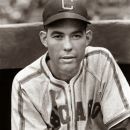
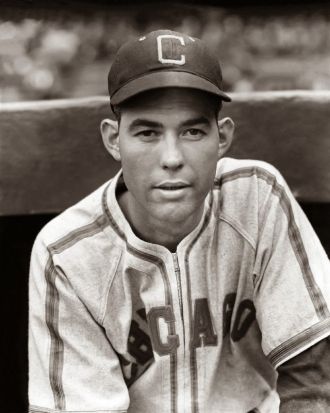
 Kathy Pinna
Kathy Pinna 